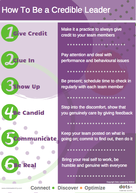Have You Asked Yourself, Am I a Credible Leader?I heard about Tom through leaders in other departments and some of his team. Tom was a top-level leader; he was sharp, rather humorous, a technically-adept-quick-study, and very good at corporate politics in his highly specialized C-suite role. However what Tom didn’t know, was that most of his team had lost total respect for him as a leader; they didn’t believe half of what he said and few trusted him anymore. As a result, team morale was at an all time low, they spent much of their time cross-checking the many stories he told, second-guessing his every move and gossiping about Tom’s life outside of work. Leadership credibility is formed whether you are conscious about it or not. Being believable and trustworthy are critical success factors to create effective, high performing teams. After all, who wants to work hard for someone they have no respect for, can’t believe or trust? 6 Bad Leadership Habits
Lets look at some common bad habits that erode and damage credibility with your team. In my experience, the following are the most common death knells to leadership credibility – all of which Tom was guilty of: 1. Taking credit – Tom was known for using other people’s ideas as his own. If you haven’t done the work, you don't get the credit. Full stop. You ARE responsible for the output of your team’s work but when you take all the credit for it, you erode trust and lose credibility. One of the best leaders I worked with once told me “credit is always for the giving, never the taking “– what a simple and effective way to lead! 2. Being clued out – Tom struggled with addressing performance or behavioural issues in the team or with key stakeholders; he delegated that to others. As the leader, it is your job (and your job only) to deal with performance or behavioural issues on your team. Be attentive to these issues and don’t turn a blind eye; it negatively impacts everyone. What also gets overlooked is bad behaviour from stakeholders the team works with day in and day out. Good leaders pay attention to difficult relationships; they find common ground and tackle issues early and head on. Every team member is watching how tuned-in you are to people who impact them and HOW you handle these delicate situations matter. 3. Hiding in your office or disappearing – Tom’s team said he disappeared a lot and when he was in, his door was always closed. Yes, you have work to do and meetings to take, but you are a leader. When your door is closed, or you are missing all the time, you send a direct message that you are not available. Make a point of checking in throughout the week to show genuine interest in the team. It’s these moments where connection and good relationships are formed. If possible schedule ‘open door’ time and let the team know you are open to interruption for important matters. 4. Avoiding difficult discussions – Tom read lots of leadership books, he frequently talked about candour and 'being open' to the team; yet when it came to addressing an issue that the whole team was talking about, he remained silent. A great leader steps into the discomfort because they care about each and every individual on their team; they know feedback is important and good for development. When you duck the issues, you demonstrate that you don’t care. To coin a great quote from one of our awesome clients… “Candour is caring”. 5. Failing to communicate – There were many unanswered questions with Tom’s team. Withholding information, not responding or failing to explain why changes were happening caused tremendous angst and spawned rumours to start. It is said that when people don’t know what is happening, they make it up! Quite literally assumptions begin to flow and we draw conclusions from anything unusual – why is that person in the office, why haven’t we heard what is going on, why was he working late, did you notice [insert obscure ideas]. When change is afoot, it is best to share what you can as soon as you can, even if it’s ‘I don’t know, yet, but I’m going to find out and keep you posted’. Just make certain you follow through! 6. Being phoney – No one on Tom’s team felt he was very genuine; he tried to make himself out to be a bit too perfect; at least that is what they all perceived. You don’t have to be a NLP (Neuro Linguistic Programming) expert to read sincerity in body language; we all can see when you’re faking it a mile away. Some leaders mistakenly feel they need to portray a certain image of themselves to be revered by others. Unfortunately it can come off as cold and calculated, leaving the team suspicious about who you really are and what you really think. No one trusts a faker. Be sincere, straightforward and humble enough to let your team know you need their help and you don’t know everything. Be the kind of person we all want to work with…the real you. The story above is 100% true (name wasn’t Tom though). In fact, there are at least a half a dozen ‘Tom’s” and “Tomasinas” I’ve worked with who have much the same habits. Sadly most are terribly unaware how they are perceived. So What Else You Can Do? A. Self Assess If you think your credibility could be in question, I have good news for you. You can practice How to Be a Credible Leader and put an end to bad habits immediately! Additionally, take time to self assess:
B. Seek Feedback Next, ask others. Consider asking your team the same questions during your 1:1 meetings. Listen closely to ‘how’ they answer, look for clues to what needs to improve. C. Pay Attention
Why Change? No amount of excuses or blame can undo the bad reputation you create, whether you like it or not. HOW you follow through and ‘show up’ has a direct reflection on your leadership credibility. Word spreads quickly when your leadership credibility is in question. Other departments hear about it, potential recruits avoid applying to your team and you lose your most valuable team members. Clients (internal or external) pick up on your habits too, they question your sincerity, work around you and avoid interactions or worse, it can cost you business or promotion and sometimes even your job. Don’t be like Tom As mentioned, we've created a free poster for you on How to Be a Credible Leader, with no strings attached! Download your own copy today! To avoid losing credibility, become more self-aware, step into the uncomfortable to learn more about how you are perceived – it takes an open mind and a vulnerable spirit to check your blind spots. Consider working with a leadership coach who can help you explore this further, when you’re ready. Let a positive leadership reputation precede you with every interaction, be true to your word, show up, be real, communicate as much as you can, and give credit as a practice. Make these your regular habits and you’ll be well on your way to strengthening your credibility. When in Doubt, Seek Help! Are you curious about what your team really thinks about you? Most times they will open up to third party when discussions are conducted in full confidence. Please keep me in mind if you’d like a trusted leadership consultant to dig a little deeper with you and your team!
0 Comments
Your comment will be posted after it is approved.
Leave a Reply. |
Most Popular Posts:
AuthorElaine Adamson is a leadership consultant with Dots Leadership Solutions Inc. A natural dot connector. Passionate about coaching team effectiveness and leadership development she shares over 25+ years of real-life tips and tricks that really work! 
Elaine believes you can discover and leverage strengths to forge a strong team dynamic despite business challenges or organizational change.
She posts some great articles on Linked In too! Topics of Interest
All
Archives By Date
November 2022
|
Specialties |
Company |
|



 RSS Feed
RSS Feed